Mirror: http://tinyurl.com/oe5sx3v
Naga worshippers of fiery pillar, Amaravati stup Smithy is the temple of Bronze Age: stambha, thãbharā fiery pillar of light, Sivalinga. Rebus-metonymy layered Indus script cipher signifies: tamba, tã̄bṛā, tambira 'copper'

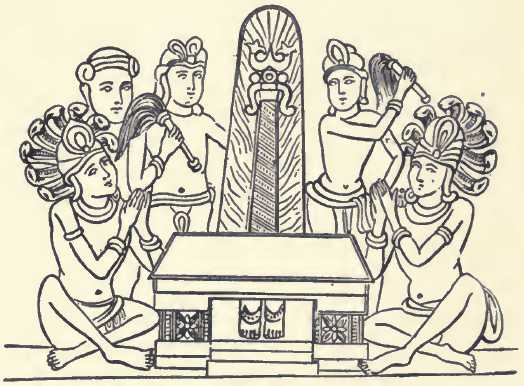
http://bharatkalyan97.blogspot.in/2015/05/smithy-is-temple-of-bronze-age-stambha_14.html

Relief with Ekamukha linga. Mathura. 1st cent. CE (Fig. 6.2). This is the most emphatic representation of linga as a pillar of fire. The pillar is embedded within a brick-kiln with an angular roof and is ligatured to a tree. Hieroglyph: kuTi 'tree' rebus: kuThi 'smelter'. In this composition, the artists is depicting the smelter used for smelting to create mũh 'face' (Hindi) rebus: mũhe 'ingot' (Santali) of mēḍha 'stake' rebus: meḍ 'iron, metal' (Ho. Munda). मेड (p. 662) [ mēḍa ] f (Usually मेढ q. v.) मेडका m A stake, esp. as bifurcated. मेढ (p. 662) [ mēḍha ] f A forked stake. Used as a post. Hence a short post generally whether forked or not. मेढा (p. 665) [ mēḍhā ] m A stake, esp. as forked. 2 A dense arrangement of stakes, a palisade, a paling. मेढी (p. 665) [ mēḍhī ] f (Dim. of मेढ ) A small bifurcated stake: also a small stake, with or without furcation, used as a post to support a cross piece. मेढ्या (p. 665) [ mēḍhyā ] a (मेढ Stake or post.) A term for a person considered as the pillar, prop, or support (of a household, army, or other body), the staff or stay. मेढेजोशी (p. 665) [ mēḍhējōśī ] m A stake-जोशी ; a जोशी who keeps account of the तिथि &c., by driving stakes into the ground: also a class, or an individual of it, of fortune-tellers, diviners, presagers, seasonannouncers, almanack-makers &c. They are Shúdras and followers of the मेढेमत q. v. 2 Jocosely. The hereditary or settled (quasi fixed as a stake) जोशी of a village.मेंधला (p. 665) [ mēndhalā ] m In architecture. A common term for the two upper arms of a double चौकठ (door-frame) connecting the two. Called also मेंढरी & घोडा . It answers to छिली the name of the two lower arms or connections. (Marathi)
मेंढा [ mēṇḍhā ] A crook or curved end rebus: meḍ 'iron, metal' (Ho. Munda)
मेंढा [ mēṇḍhā ] A crook or curved end rebus: meḍ 'iron, metal' (Ho. Munda)
A stunning explanation for the Bronze Age principal life-activity metaphor as sivalinga appears in Candi Sukuh temple. This temple has a sivalinga and an inscription. The inscription explains the raison d'etre for the linga which is iconographically unique with four round balls on the tip of the skambha, pillar 6 feet tall. The inscribed hieroglyphs are: 4 round balls, a sword; and inscription in Javanese, referring to 'inauguration of the holy ganggasudhi...' The round balls are khāṇḍā. The pillar is lo'loha, copper'; together, lokhāṇḍā 'metal implements'. The phonetic reinforcer is sword: khaṇḍa 'sword'. Ganggasudhi is a veneration of the ancestors.
This note sees an essential unity among the Sit Shamshi bronze, the Dong Son bronze drum tympanum with Indus Script hieroglyphs and the sivalingas found in Sarasvati-Sindhu civilization of ca. 3rd millennium BCE in the context of the sivalinga as a metaphor of metalwork life-activities of the Bronze Age.
With the iconographic reinforcement of Candi Sukuh, Swami Vivekananda's inspired explanation for Atharva Veda Skambha Sukta as a representation of Yupa-Skambha gets validated. The skambha, the cosmic dance of creation explains the processes of purification which result in the metalforms arsing out of earth impregnated in fire of the furnace or crucible. The demonstration of the cosmic dance of creation occurs in the temple, the smithy, kole.l
See: http://bharatkalyan97.blogspot.in/2015/09/worship-of-sivalingam-in-harappa.html Swami Vivekananda explains Yupa-skambha and AV skambha sukta.
Skambha Sukta ( Atharva Veda X-7 ) begins with this enquiry to unravel the implanted truth:
kásminn áṅge tápo asyā́dhi tiṣṭhati kásminn áṅga r̥tám asyā́dhy ā́hitam
kvà vratáṃ kvà śraddhā́sya tiṣṭhati kásminn áṅge satyám asya prátiṣṭhitam 1
kásminn áṅge tápo asyā́dhi tiṣṭhati kásminn áṅga r̥tám asyā́dhy ā́hitam
kvà vratáṃ kvà śraddhā́sya tiṣṭhati kásminn áṅge satyám asya prátiṣṭhitam 1
1.Which of his members is the seat of fervour: Which is the base of Ceremonial Order? Where in him standeth Faith? Where Holy Duty? Where, in what part of him is truth implanted?
The sequences of questions posed in 44 sukta verses are an inquiry as profound as the Nasadiya Sukta of Rigveda. The wonder of the Rishi and the insights provided linking earth and heaven in an axis mundi the primordial pillar signified by the skambha (linga) metaphor is unsurpassed in any cosmic-consciousness enquiries of all time.
This wonder, this enquiry gets embedded in some hieroglyph-multiplexes of Indus Script Corpora and on Bhuteswar friezes linking sivalinga to a smelter and processes of the smith working with minerals to produce metallic implements. This is one reason why the stella are implanted in almost every fire-altar of Sarasvati-Sindhu civilization.
 Austro-asiatic languages. Pinnow's map.
Austro-asiatic languages. Pinnow's map.
See: http://www.jstor.org/stable/41466748 The Austroasiatic Munda Population from India and its Enigmatic Origin: A HLA Diversity Study
MARIA EUGENIA RICCIO, JOSÉ MANUEL NUNES, MELISSA RAHAL, BARBARA KERVAIRE, JEAN-MARIE TIERCY and ALICIA SANCHEZ-MAZAS
Human Biology
Vol. 83, No. 3 (June 2011), pp. 405-435
Geographic distribution of two linguistic subfamilies linked to Indian sprachbund.
 After Charles Higham, 1996, The Bronze Age of Southeast Asia, p. 295Map of bronze age sites which correlate with the Austro-asiatic Indian sprachbund map.
After Charles Higham, 1996, The Bronze Age of Southeast Asia, p. 295Map of bronze age sites which correlate with the Austro-asiatic Indian sprachbund map.This extension of Indian sprachbund and presence in Far East may explain the Indus Script hieroglyphs signifying metalwork on Dong Son Bronze Drums cire perdue on the surface tympanum of the drums
Hieroglyphs on Dong Son Bronze Drums explained by Indus Script Cipher
http://bharatkalyan97.blogspot.in/2015/02/hieroglyphs-on-dong-son-drums-relate-to.html

Hieroglyph: arka 'sun' Rebus: eraka 'copper' 861 Ta. eṟi (-pp-, -tt-) to shine, glitter; eṟippu lustre, brightness, hot sun. Ma. eṟikka to shine (as sun); eṟippu sunshine. (DEDR 861) Ka. eṟe to pour any liquids, cast (as metal); n. pouring; eṟacu, ercu to scoop, sprinkle, scatter, strew, sow; eṟaka, eraka any metal infusion; molten state, fusion. Tu. eraka molten, cast (as metal); eraguni to melt.(DEDR 866)
An abiding metaphor in Dharma-Dhamma traditions is the sivalinga. The metaphor relates to sacred metalwork producing: lokhāṇḍā 'metal implements'. The expression finds iconographic Indus Script ciphertext, together with an inscription explaining Ganga Sudhi 'Ganga purification' -- veneration of ancestors, pitr-s, in Candi Sukuh temple dedicated to metalwork in Java, Indonesia.
http://bharatkalyan97.blogspot.in/2015/09/bronze-age-lokhanda-metal-tools-pots.html Ekhamukhalinga and linga with four or five faces are anthropomorphs imaging cosmos with human attributes.
What wonder is it that mere earth yields metal implements purified through fire? What wonder is it that explains the transmutations involving purificatory processes? What wonder is this cosmic dance in dagoba, dhatugarbha? What wondrous techniques have been handed down to us by our pitr-s, our ancestors creating ploughshares, implements which transform social living? Is he lukulisa - the divnity of the mace? Lakulisha (Sanskrit: Lakuliśa, Devnagari: लकुलिश) (Etymology: लगुड (staff) or लकुट (mace) + ईश (lord) = meaning, the lord with a staff or mace or club or stick) is venerated as a form of Siva by Pasupathas.
Lakulisha among his four disciples Kusika, Garga, Mitra, and Kaurushya, rock-cut stone relief, Cave Temple No. 2 at Badami, Karnataka, Early Chalukya dynasty, second half of the 6th century CE
Statue of Lakulisha, Pratihara, 9th century CE."According to a tradition stated in the Linga Purana, Lakulisha is considered as the 28th and the last avatar of Shiva and the propounder of Yoga system. According to the same tradition, Lakulisha had four disciples, viz., Kaurushya, Garga, Mitra and Kushika. According to another tradition mentioned in the Avanti Khanda of the Skanda Purana, Lakulisha and his four disciples while passing Mahakalavana, installed a linga at that place, which was then known as Kayavarohaneshvara.[2] The Kurma Purana (Chap. 53), the Vayu Purana (Chap. 23), and the Linga Purana (Chap. 24) predicted that Shiva (Maheshvara) would appear in the form of a wandering monk called 'Lakulin' or 'Nakulisha', and that he would have four disciples named, Kushika, Garga, Mitra, and Kanrushya, who would re-establish the cult of Pashupati and would therefore be called Pashupata(s). Lakulisha was the fruition of these divine predictions. According to Vayu Purana V. 1.23.202-214, Lakulisha was a contemporary of Vyasa and Krishna, and was the 28th incarnation of Rudra (Shiva)."
https://en.wikipedia.org/wiki/Lakulish
Metallic box enclosing Ishtalinga worn on the body by Lingayata.

A Lingayat ritual locket which holds iṣṭaliṅga (Kannada: ಇಷ್ಟಲಿಂಗ) 19th century, Tamil Nadu. lingavanta is the "one who wears aiṣṭaliṅga'.
These are seafaring artisans from Indian sprachbund who took their culture and sivalinga metaphors to Hanoi, Vietnam evidenced by the exquisite cire perdue castings on Dong Son bronze drums with Indus Script hieroglyphs: heron, antelope, sun: kanka 'heron' Rebus: kanaga 'brazier'; eruvai 'kite' Rebus: eruva 'copper' mlekh 'goat' Rebus: milakkhu 'copper'; ranku 'antelope' Rebus: ranku 'tin' arka 'sun' Rebus: arka, eraka 'copper, moltencast'.
Swami Vivekananda has explained the metaphor of Yupa-Skambha explained in breath-taking theology of Atharva Veda Skambha Sukta (X.7). Yes, the yupa-skambha which is present as a stella in almost every fire-altar uncovered in Sarasvati-Sindhu civilization archaeological sites. The stalks -- three of them -- are also signified on the Sit Shamshi bronze which is sandhyavandanam for the sun, offering oblations to sun divinity. The background of Sit Shamshi bronze is dominated by a dagoba, dhatugarbha, venerating the mere earth which yields the minerals worked on by bronze-smiths of yore. The smithy becomes a temple. kole.l is smithy. kole.l is temple. (Kota) lokhāṇḍā 'metal implements' are divine manifestations of the cosmic dancer Mahadeva, Mahesvara and hence metaphors of veneration in awe at the phenomena which are the axis mundi linking earth and heaven. Hence, the Yupa skambha as expounded in Atharva Veda Skambha Sukta, a metaphor of briliance and the very pinnacle of theological enquiry explaining the processes of creation and the cosmic dance itself in every conscious being in the universe. This is the purifier, the PotR, the potti priest with the trefoil-decorated robe and wearing fillet on the forehead and on the shoulder. Hence, the veneration apparent in the trefoil-decorated base PLUS sivalinga discovered in Mohenjo-daro.
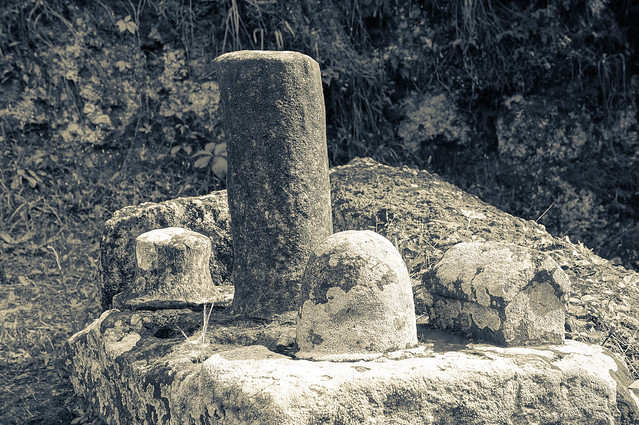 Cerveteri. Etrucian skambha and sivalinga.
Cerveteri. Etrucian skambha and sivalinga.Tomb Markers (cippi) from Cerveteri
An assortment of tomb markers (cippus, plural cippi), from the Etruscan Banditaccia necropolis of Cerveteri (Caere). These are no longer in situ. Markers like these, usually without any inscriptions or figural decoration, were set up on small stands before the doorways of chamber tombs.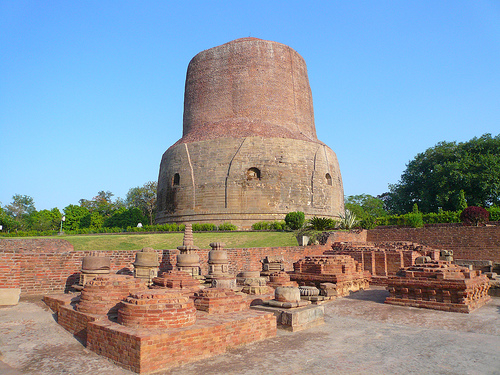 Stupa. Sarnath.
Stupa. Sarnath.Lingam, grey sandstone in situ, Harappa, Trench Ai, Mound F, Pl. X (c) (After Vats). "In an earthenware jar, No. 12414, recovered from Mound F, Trench IV, Square I... in this jar, six lingams were found along with some tiny pieces of shell, a unicorn seal, an oblong grey sandstone block with polished surface, five stone pestles, a stone palette, and a block of chalcedony..." (Vats, EH, p. 370)
The iconography is explained in Bhuteshwar friezes and in the temple of Candi Sukuh on the Maritime Tin Route. The iconography is also vivid in the two skambhas of Dholavira.
 What is described as a “pinecone” at the small museum at Arbeia (South Shields, near Newcastle-upon-Tyne, U.K.), which was found in Romano-British context.
What is described as a “pinecone” at the small museum at Arbeia (South Shields, near Newcastle-upon-Tyne, U.K.), which was found in Romano-British context.https://aediculaantinoi.wordpress.com/2012/04/06/megalensia-the-third-day/


File:Worship of Shiva Linga by Gandharvas - Shunga Period - Bhuteshwar - ACCN 3625

See: http://bharatkalyan97.blogspot.in/2015/05/rigveda-soma-not-herb-not-drink-but.html A tree associated with smelter and linga from Bhuteshwar, Mathura Museum. Architectural fragment with relief showing winged dwarfs (or gaNa) worshipping with flower garlands, Siva Linga. Bhuteshwar, ca. 2nd cent BCE. Lingam is on a platform with wall under a pipal tree encircled by railing. (Srivastava, AK, 1999, Catalogue of Saiva sculptures in Government Museum, Mathura: 47, GMM 52.3625) The tree is a phonetic determinant of the smelter indicated by the railing around the linga: kuṭa, °ṭi -- , °ṭha -- 3, °ṭhi -- m. ʻ tree ʼ Rebus: kuṭhi 'smelter'. kuṭa, °ṭi -- , °ṭha -- 3, °ṭhi -- m. ʻ tree ʼ lex., °ṭaka -- m. ʻ a kind of tree ʼ Kauś.Pk. kuḍa -- m. ʻ tree ʼ; Paš. lauṛ. kuṛāˊ ʻ tree ʼ, dar. kaṛék ʻ tree, oak ʼ ~ Par. kōṛ ʻ stick ʼ IIFL iii 3, 98. (CDIAL 3228). See:
This museum artifact is comparable to the monumental 6 ft. tall inscribed stone linga discovered in Candi Sukuh as the sacred, venerated pillar of light, described in Atharva Veda Stambha Sukta.
![]()
![]()
![]()
gaṇḍa -- m. ʻ four' (Munda) गंडा[ gaṇḍā ] m An aggregate of four (cowries or pice). (Marathi) <ganDa>(P) {NUM} ``^four''. Syn. <cari>(LS4), <hunja-mi>(D). *Sa., Mu.<ganDa> `id.', H.<gA~Da> `a group of four cowries'. %10591. #10511.<ganDa-mi>(KM) {NUM} ``^four''. |<-mi> `one'. %10600. #10520. Ju<ganDa>(P) {NUM} ``^four''. gaṇḍaka m. ʻ a coin worth four cowries ʼ lex., ʻ method of counting by fours ʼ W. [← Mu. Przyluski RoczOrj iv 234]S. g̠aṇḍho m. ʻ four in counting ʼ; P. gaṇḍā m. ʻ four cowries ʼ; B. Or. H. gaṇḍā m. ʻ a group of four, four cowries ʼ; M. gaṇḍā m. ʻ aggregate of four cowries or pice ʼ.(CDIAL 4001)
``^penis'':So. laj(R)~ lij ~ la'a'j~ laJ/ laj~ kaD `penis'.
Hieroglyph: kanda m. bulbous root (Samskritam) Ash. piċ-- kandə ʻ pine ʼ Rebus:lo-khānḍa 'tools, pots and pans, metal-ware'. लोखंड [lōkhaṇḍa ] 'metalwork' Rebus: loh 'copper, iron, metal' (Indian sprachbund, Meluhha).
![]() Thyrsus staff tied with taenia and topped with a pine cone
Thyrsus staff tied with taenia and topped with a pine cone
Candi Cetho. Lingga shows a pair of balls at the top of the penis -- to be read rebus as Meluhha hieroglyph composition: lo-khaNDa, penis + 4 balls; Rebus: iron, metalware.
The four balls of the penis are also clearly shown on a 6 ft. tall linga inscribed with 1. a sword; and 2. inscription in Javanese, referring to 'inauguration of the holy ganggasudhi...'

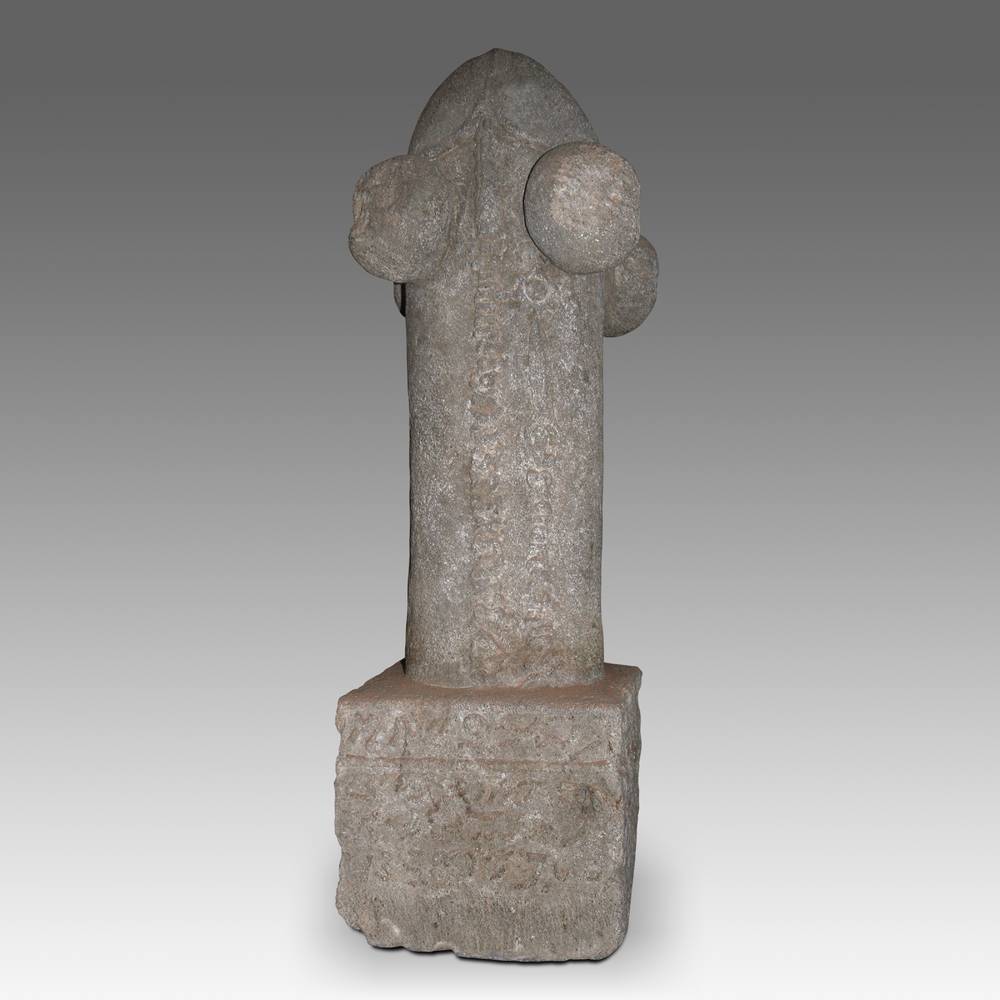

See: http://bharatkalyan97.blogspot.in/2015/01/sekkizhar-periya-puranam-candi-sukuh.html Histoire ancienne des Etats hindouises along the Tin Road from Haifa to Hanoi. NaMo, Obama, announce United Indian Ocean States.
lo 'penis' Rebus: loh 'copper, metal'
Hieroglyphs: gaṇḍa 'swelling' gaṇḍa 'four' gaṇḍa 'sword'
Rebus: kāṇḍa ‘tools, pots and pans and metal-ware’ (Marathi)
Together, hieroglyphs: lo + gaṇḍa. Rebus: लोखंड [ lōkhaṇḍa ] 'metalwork'
Metaphor: Sh. K.ḍoḍ. lō m. ʻ light, dawn ʼ; L. awāṇ. lō ʻ light ʼ; P. lo f. ʻ light, dawn, power of seeing, consideration ʼ; WPah. bhal. lo f. ʻ light (e.g. of moon) ʼ.(CDIAL 11120). + kaṇṭa 'manliness'. Metaphorical rendering of the effulgence (sun and moon) associated with the pillar of light yielding the imagery of an representation of a fiery pillar with unfathomable beginning, unreachable end, thus of infniity of Mahadeva representing the paramaatman for the aatman in search of nihs'reyas (moksha), from Being to Becoming, the way earth and stones transmute into metal in the smelter and smithy, kole.l 'smithy, temple'.
Bharatiyo, 'metalcasters' (Gujarati) are awestruck by this parallel with the cosmic energy replicated in the energies of the smelter, fire-altar and smithy. Hence, the veneration of the linga + 4 spheres as the essence of every phenomenon on cosmos, on the globe, of the world. These hieroglyphs and related metaphors thus yield the gestalt of Bharatiyo, 'metalcasters' (Meluhha). This enduring metaphor finds expression in sculptures on many Hindu temples of Eurasia.
The gloss gaṇḍu 'manliness' (Kannada); 'bravery, strength' (Telugu) is a synonym of the expression on Candi Suku linga inscription: 'sign of masculinity is the essence of the world'. Thus, the gloss lokhaṇḍa which is a direct Meluhha speech form related to the hieroglyph composition on Candi Suku inscription is the sign of masculinity. The rebus renderings of khandoba or kandariya mahadeva are elucidations of the rebus gloss: kaṇḍa, 'mahadeva S'iva or mahes'vara.' The hieroglyphs deployed on the 1.82m. tall stone sculpture of linga with the inscription and hieroglyphs of sword, sun, moon and four balls deployed just below the tip of the phallus are thus explained as Meluhha speech: lokhaṇḍa. The rebus rendering of the phrase is: lo 'light' and kaṇṭa 'manliness'. These attributes constitute the effulgence of the linga as the fiery pillar, skhamba venerated in Atharva Veda Skhamba sukta as the cosmic effulgence as the cosmic essence.
gaṇḍa -- m. ʻ four' (Munda) गंडा[ gaṇḍā ] m An aggregate of four (cowries or pice). (Marathi) <ganDa>(P) {NUM} ``^four''. Syn. <cari>(LS4), <hunja-mi>(D). *Sa., Mu.<ganDa> `id.', H.<gA~Da> `a group of four cowries'. %10591. #10511.<ganDa-mi>(KM) {NUM} ``^four''. |<-mi> `one'. %10600. #10520. Ju<ganDa>(P) {NUM} ``^four''. gaṇḍaka m. ʻ a coin worth four cowries ʼ lex., ʻ method of counting by fours ʼ W. [← Mu. Przyluski RoczOrj iv 234]S. g̠aṇḍho m. ʻ four in counting ʼ; P. gaṇḍā m. ʻ four cowries ʼ; B. Or. H. gaṇḍā m. ʻ a group of four, four cowries ʼ; M. gaṇḍā m. ʻ aggregate of four cowries or pice ʼ.(CDIAL 4001)
gaṇḍa -- m. ʻswelling, boil, abscessʼ(Pali)
Rebus: kaṇḍ 'fire-altar' (Santali) kāṇḍa ‘tools, pots and pans and metal-ware’ (Marathi) खंडा [ khaṇḍā ] m A sort of sword. It is straight and twoedged. खांडा [ khāṇḍā ] m A kind of sword, straight, broad-bladed, two-edged, and round-ended.खांडाईत [ khāṇḍāīta ] a Armed with the sword called खांडा. (Marathi)
लोखंड [ lōkhaṇḍa ] n (लोह S) Iron.लोखंडकाम [ lōkhaṇḍakāma ] n Iron work; that portion (of a building, machine &c.) which consists of iron. 2 The business of an ironsmith.
लोखंडी [ lōkhaṇḍī ] a (लोखंड) Composed of iron; relating to iron.
``^penis'':So. laj(R)~ lij ~ la'a'j~ laJ/ laj~ kaD `penis'.
Sa. li'j `penis, esp. of small boys'.Sa. lO'j `penis'.Mu. lOe'j ~ lOGgE'j `penis'. ! lO'jHo loe `penis'Ku. la:j `penis'.@(C289) ``^penis'':Sa. lOj `penis'.Mu. lOj `penis'.KW lOj@(M084) (Munda etyma)
Rebus: lo 'copper' lōhá ʻ red, copper -- coloured ʼ ŚrS., ʻ made of copper ʼ ŚBr., m.n. ʻ copper ʼ VS., MBh. [*rudh -- ] Pa. lōha -- m. ʻ metal, esp. copper or bronze ʼ; Pk. lōha -- m. ʻ iron ʼ, Gy. pal. li°, lihi, obl. elhás, as. loa JGLS new ser. ii 258; Wg. (Lumsden) "loa"ʻ steel ʼ; Kho. loh ʻ copper ʼ; S. lohu m. ʻ iron ʼ, L. lohā m., awāṇ. lōˋā, P. lohā m. (→ K.rām. ḍoḍ. lohā), WPah.bhad. lɔ̃un., bhal. lòtilde; n., pāḍ. jaun. lōh, paṅ. luhā, cur. cam. lohā, Ku. luwā, N. lohu, °hā, A. lo, B. lo, no, Or. lohā, luhā, Mth. loh, Bhoj. lohā, Aw.lakh. lōh, H. loh, lohā m., G. M. loh n.; Si. loho, lō ʻ metal, ore, iron ʼ; Md. ratu -- lō ʻ copper ʼ. WPah.kṭg. (kc.) lóɔ ʻ iron ʼ, J. lohā m., Garh. loho; Md. lō ʻ metal ʼ.(CDIAL 11158)http://bharatkalyan97.blogspot.in/2015/01/meluhha-hieroglyphs-and-candi-sukuh.htmlHieroglyph: kanda m. bulbous root (Samskritam) Ash. piċ-- kandə ʻ pine ʼ Rebus:lo-khānḍa 'tools, pots and pans, metal-ware'. लोखंड [lōkhaṇḍa ] 'metalwork' Rebus: loh 'copper, iron, metal' (Indian sprachbund, Meluhha).
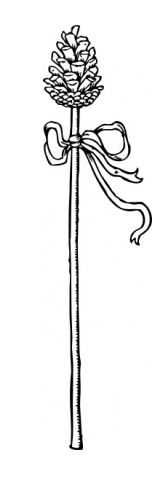 Thyrsus staff tied with taenia and topped with a pine cone
Thyrsus staff tied with taenia and topped with a pine coneSacred metalwork. See: http://bharatkalyan97.blogspot.in/2015/06/sacred-metalwork-bronze-age-hieroglyphs.html
 Bali sivalinga
Bali sivalinga Five-faced Mukhalinga,Himachal Pradesh; currently in LACMA
Five-faced Mukhalinga,Himachal Pradesh; currently in LACMA One-faced Mukhalinga,Maharashtra; currently inLACMA
One-faced Mukhalinga,Maharashtra; currently inLACMA Five-headed Mukhalinga Budanilkantha, Nepal
Five-headed Mukhalinga Budanilkantha, Nepal Four-headed metal cover as Mukhalinga, Nepal; currently inMuseum of Asian Art
Four-headed metal cover as Mukhalinga, Nepal; currently inMuseum of Asian Art
 Ekamukha sivalinga
Ekamukha sivalinga Sivalinga. Kathmandu
Sivalinga. Kathmandu
Hanumanghat. Sivalingas. Kathmandu.
 Sivalinga. Angkor Wat.
Sivalinga. Angkor Wat.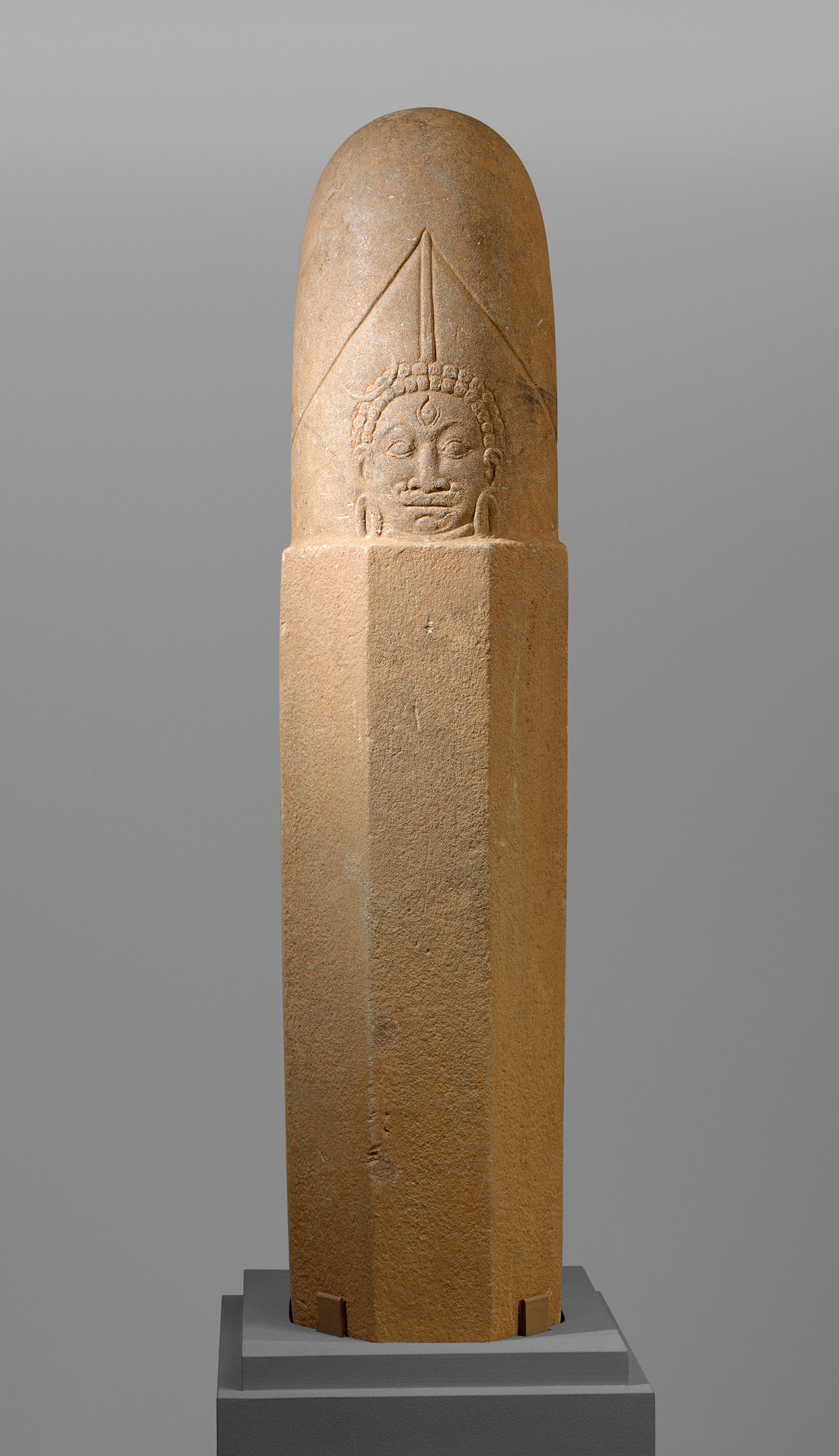 Si Thep sivalinga, Thailand.
Si Thep sivalinga, Thailand. Sivalinga. Buddha temple. Bangkok
Sivalinga. Buddha temple. Bangkok Sivalinga. Yot Kaeng. Thailand.
Sivalinga. Yot Kaeng. Thailand.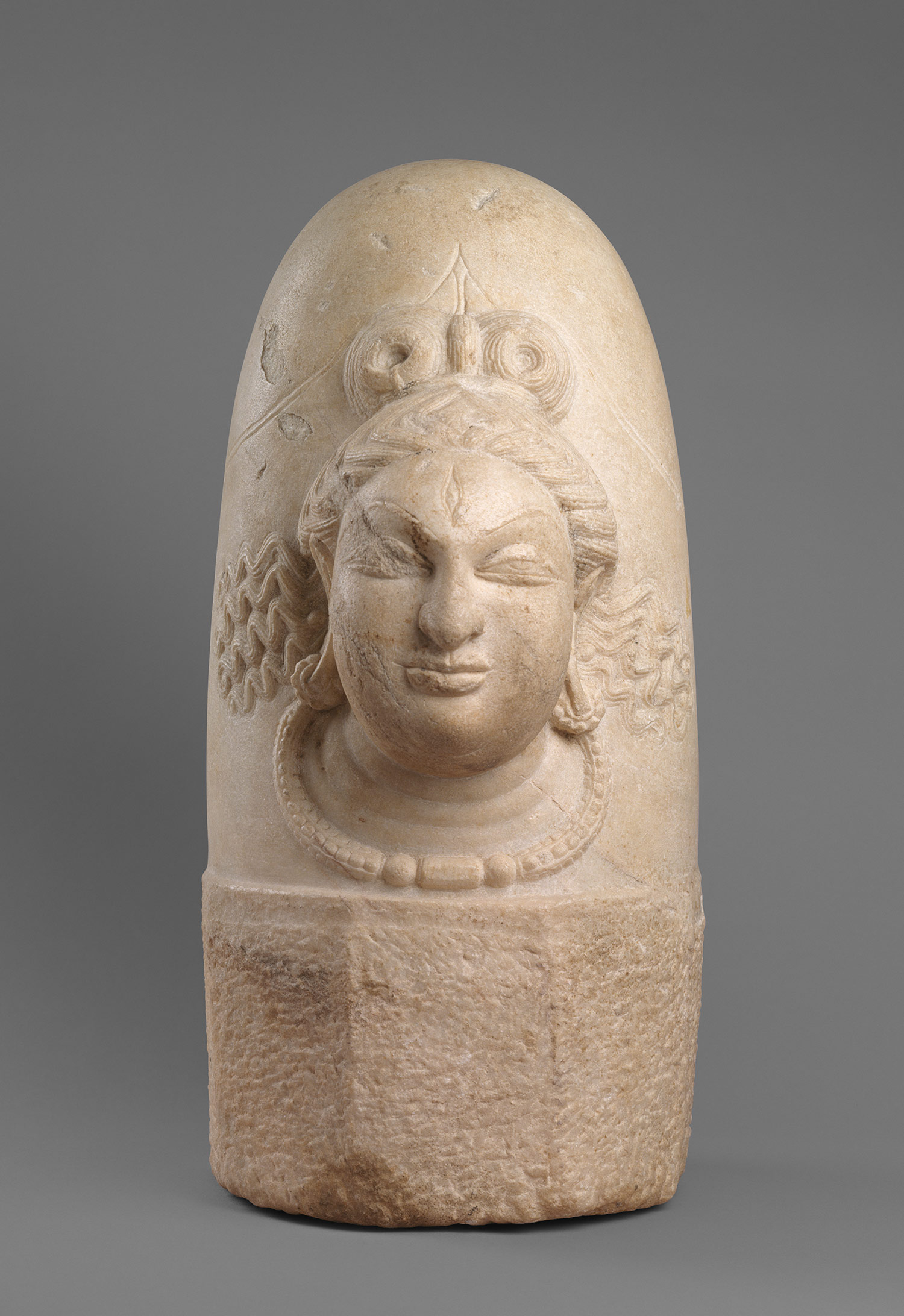 Cambodia Stone; H. 52 3/4 in. (134 cm)
Cambodia Stone; H. 52 3/4 in. (134 cm) 
Reverse reclining Vishnu. Front Sivalinga.

Kabl Spean. A river flows over the toe of Anantas'ayana, reclining Vishnu.

Shiva and Parvati on Nandi. The lingas are carved underwater in front of them.Kabl Spean.

Brahma. Kabl Spean. Cambodia.
 Prasat Thom sivalinga, Koh Ker, Cambodia
Prasat Thom sivalinga, Koh Ker, Cambodia Baneswar Sivalinga twins.
Baneswar Sivalinga twins. Sivalinga. Pashupatinath. Nepal.
Sivalinga. Pashupatinath. Nepal. Sivalinga. Gudimallam. India.
Sivalinga. Gudimallam. India.
 Sivalinga. Thailand.
Sivalinga. Thailand. Sivalinga. Nagarkot. Nepal.
Sivalinga. Nagarkot. Nepal.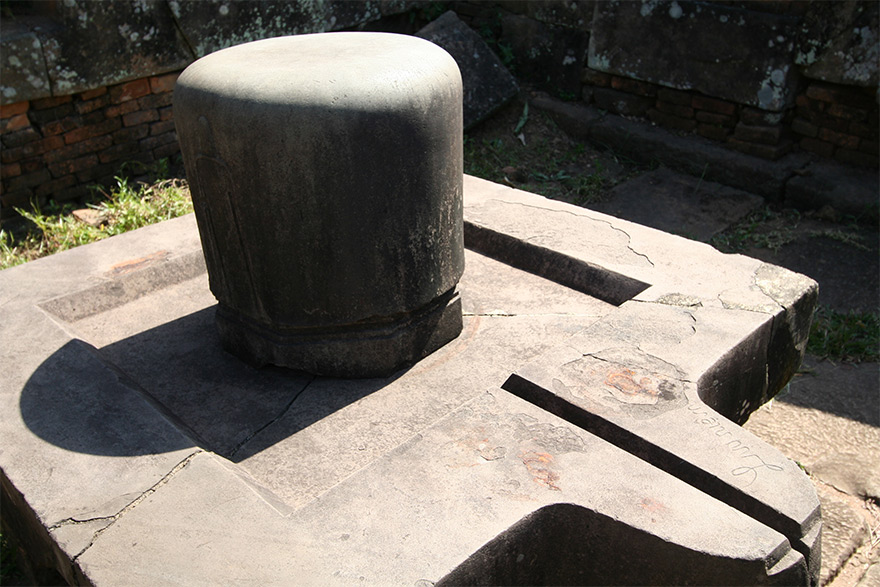 Sivalinga. Vietnam.
Sivalinga. Vietnam.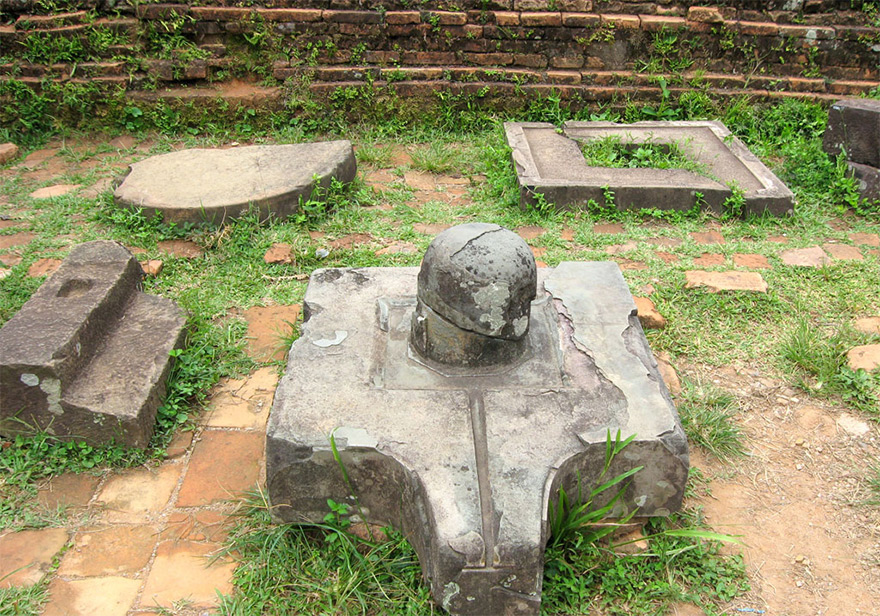 Sivalinga. My Son. Vietnam
Sivalinga. My Son. Vietnam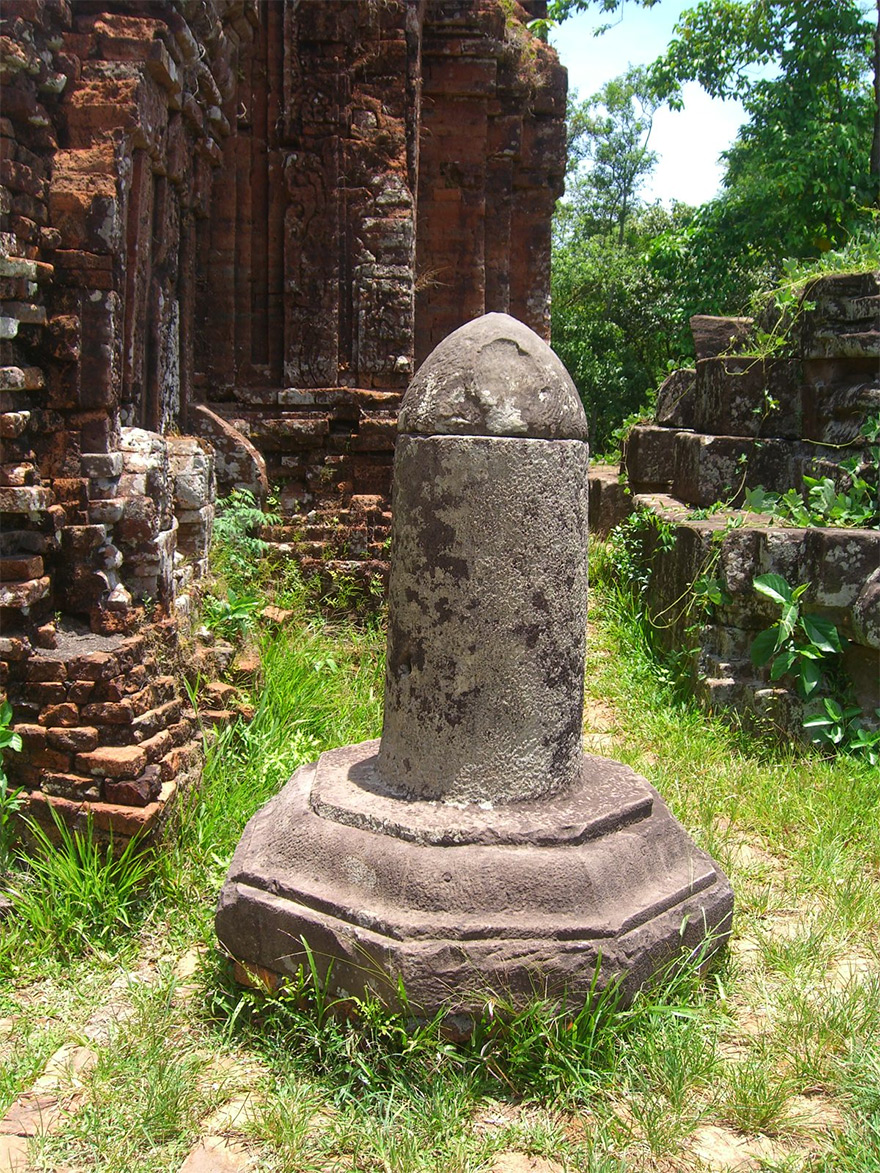 Sivalinga. My Son. Vietnam.
Sivalinga. My Son. Vietnam.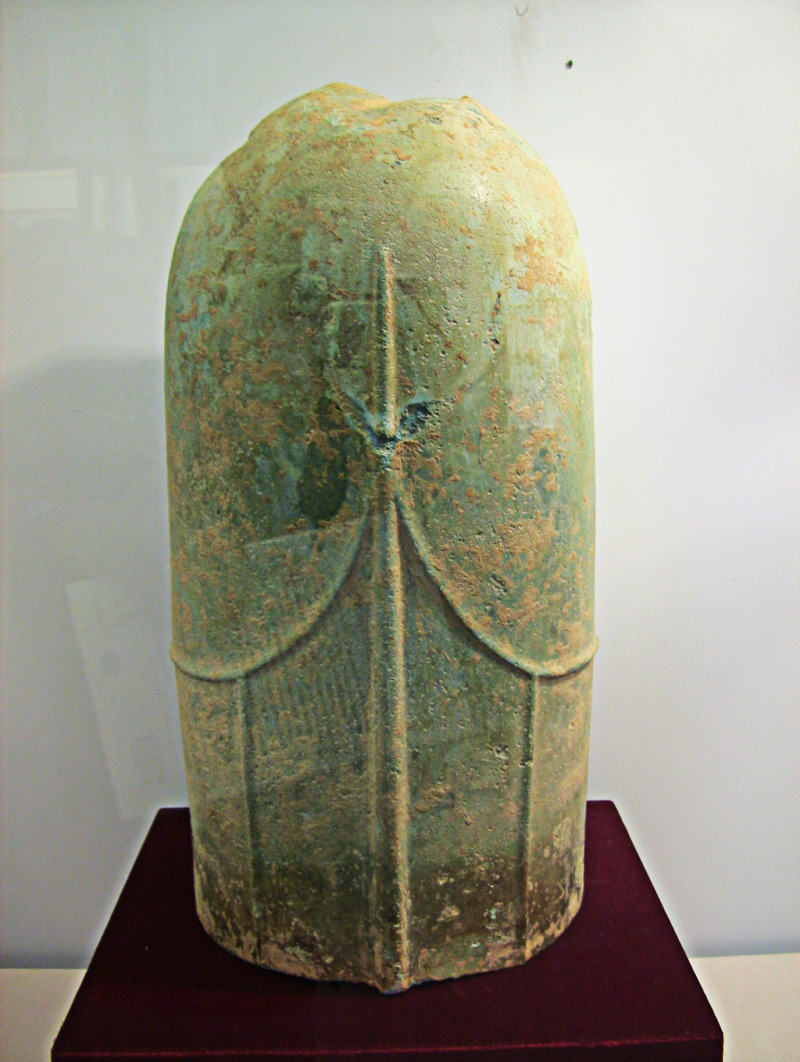 Copper Sivalinga. Cat Tien. Vietnam.
Copper Sivalinga. Cat Tien. Vietnam.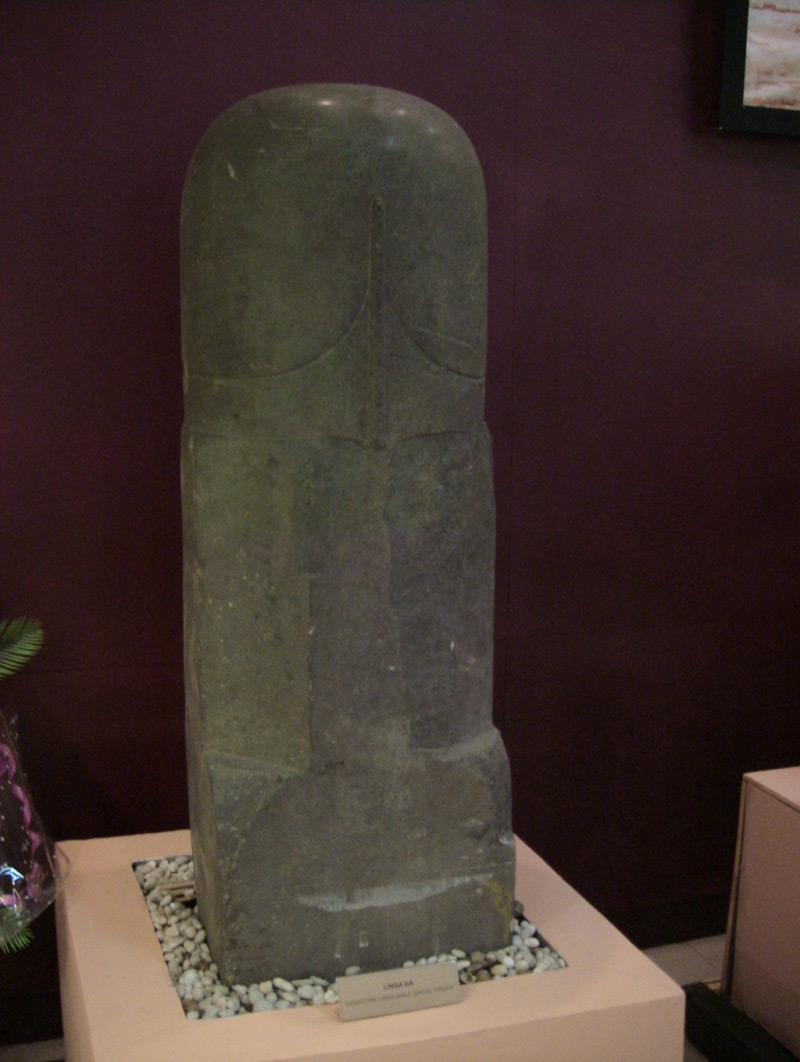 Sivalinga. Cat Tien. Now in National Museum, Vietnam.
Sivalinga. Cat Tien. Now in National Museum, Vietnam.
Reclining Vishnu with Sivalingas in front.

Kabl Spean.

River of a thousand lingas. Kabl Spean.

Kabl Spean
Hieroglyph: Summit of hill: Ta. kuṉṟam, kuṉṟu hill, mountain; kuṉṟuvar mountaineers. Ma. kunnam mountain; kunnu hill, mountain; conical heap, hill-fort; kunnan mountaineer; kunnikka to pile up, heap up; kuṟu hill. To. küḏ-xas̱, küḏs̱ large rock standing by itself. Ka. koṇḍa hill, mountain (< Te.). Koḍ. kundï mountain. Te. koṇḍa, (inscr.) konṟa mountain, hill, rock; koṇḍavã̄ḍu a mountaineer; kuruva, (Inscr.) kuṟuva a raised ground, footpath on a hill. Nk. (Ch.) kod hill. Pa. kondi (pl. kondkul) mountain. Ga. (S.2) konḍekor the Gadbas near Salur; (S.3) koṇḍavān a hill-man. Go. (W.) kuṛu hill; (Ph.) kuṛo mountain, forest (Voc. 795). Konḍa goṟon (pl. goṟoku/ goṟonku) hill, mountain, forest on a hill.(DEDR 1864)
kōh
<gOtO>(P) {N} ``^hillock''. *Mu.<guTu> `a small jungle, a small hillock', Ho<guTu> `hillock', Sad.<gUTU>. %11861. #11771.<kunDa>(B)F {N} ``^forest, ^hill, ^mountain; ^deity presiding over the hill''. @B06070,N469. #19151. <Dumaw = kuNDa>(F) {N} ``^hill''. !noun phrase cf. 1003. @N475. #9623.Go<koDki>(Z) [koDki],[koRki] {N} ``^mountain''. *LoanGo<kun>(Z),,<kunDa>(ZA),,<kunDan>(Z),<kunDa?>(Z) {N} ``^hill, ^mountain, ^forest''. ??(Z) orig. <kun=Dan>,<kun=Da?>,<kun=Da>.?.Re<kunDa>(B)F {N} ``^forest, ^hill, ^mountain; ^deity presiding over the hill''.(Munda) غونډئِي g̠ẖūnḏḏaʿī, s.f. (6th) A mound or detached hill separated from the higher range. Sing. and Pl.(Pashto)
Gaw. khaṇḍa ʻ hill pasture ʼ (see ab.); Bshk. khan m. ʻ hill ʼ, Tor. khān, (Grierson) khaṇḍ, Mai. khān, Chil. Gau. kān, Phal. khã̄ṇ; Sh. koh. khŭṇ m., gur. khonn, pales. khōṇə, jij. khɔ̈̄ṇ ʻ mountain ʼ, gil. (Lor.) kh*ln m. ʻ mountain pass ʼ.(CDIAL 3792) Koṭi (f.) [cp. Sk. koṭi & kūṭa
S. Kalyanaraman
Sarasvati Research Center
September 23, 2015
Skambha sukta (AV X.7) meaning:
1)Which of his members is the seat of Fervour: Which is the base of Ceremonial Order? Where in him standeth Faith? Where Holy Duty? Where, in what part of him is truth implanted?
2)Out of which member glows the light of Agni? Form which proceeds the breath of Mātarisvan? From which doth Chandra measure out his journey, travelling over Skambha's mighty body?
3)Which of his members is the earth's upholder? Which gives the middle air a base to rest on? Where, in which member is the sky established? Where hath the space above the sky its dwelling?
4)Whitherward yearning blazeth Agni upward? Whitherward yearning bloweth Mātarisvan? Who out of many, tell me, is that Skambha to whom with long- ing go the turning pathways?
5)Whitheward go the half-months, and, accordant with the full year, the months in their procession? Who out of many, tell me, is that Skambha to whom go seasons and the groups of seasons?
6)Whitherward yearning speed the two young Damsels, accordant, Day and Night, of different colour? Who out of many, tell me, is that Skambha to whom the Waters take their way with longing?
7)Who out of many, tell me, is that Skambha, On whom Prajāpati set up and firmly stablished all the worlds?
8)That universe which Prajāpati created, wearing all forms,, the highest, midmost, lowest, How far did Skambha penetrate within it? What portion did he leave unpenetrated?
9)How far within the past hath Skambha entered? How much of him hath reached into the future? That one part which he set in thousand places,—how far did Skambha penetrate within it?
10)Who out of many, tell me, is that Skambha in whom men recognize the Waters, Brahma, In whom they know the worlds and their enclosures, in whom are non-existence and existence?
11)Declare that. Skambha, who is he of many, In whom, exerting every power, Fervour maintains her loftiest vow; In whom are comprehended Law, Waters, Devotion and Belief
12)Who out of many, tell me, is that Skambha On whom as their foundation earth and firmament and sky are set; In whom as their appointed place rest Fire and Moon and Sun and Wind?
13)Who out of many, tell me, is that Skambha He in whose body are contained all three-and-thirty Deities?
14)Who out of many, tell me, is that Skambha. In whom the Sages earliest born, the Richas, Sāman, Yajus, Earth, and the one highest Sage abide?
15)Who out of many, tell me, is the Skambha. Who comprehendeth, for mankind, both immortality and death, He who containeth for mankind the gathered waters as his veins?
16)Who out of many, tell me, is that Skambha, He whose chief arteries stand there, the sky's four regions, he irk whom Sacrifice putteth forth its might?
17)They who in Purusha understand Brahma know Him who is. Supreme. He who knows Him who is Supreme, and he who knows the Lord of Life, These know the loftiest Power Divine, and thence know Skam- bha thoroughly.
18)Who out of many, tell me, is that Skambha Of whom Vaisvānara became the head, the Angirases his eye, and Yātus his corporeal parts?
19)Who out of many, tell me, is that Skambha Whose mouth they say is Holy Lore, his tongue the Honey- sweetened Whip, his udder is Virāj, they say?
20)Who out of many, tell me, is that Skambha From whom they hewed the lichas off, from whom they chipped the Yajus, he Whose hairs are Sāma-verses and his mouth the Atharvāngi- rases?
21)Men count as 'twere a thing supreme nonentity's conspicuous branch; And lower man who serve thy branch regard it as an entity.
22)Who out of many, tell me, is that Skambha In whom Ādityas dwell, in whom Rudras and Vasus are contained, In whom the future and the past and all the worlds are firmly set;
23)Whose secret treasure evermore the three-and thirty Gods protect? Who knoweth now the treasure which, O Deities ye watch and guard?
24)Where the Gods, versed in Sacred Lore, worship the loftiest Power Divine The priest who knows them face to face may be a sage who knows the truth.
25)Great, verily, are those Gods who sprang from non-existence into life. Further, men say that that one part of Skambha is nonentity.
26)Where Skambha generating gave the Ancient World its shape and form, They recognized that single part of Skambha as the Ancient World,
27)The three-and-thirty Gods within his body were disposed as limbs: Some, deeply versed in Holy Lore, some know those three-and- thirty Gods.
28)Men know Hiranyagarbha as supreme and inexpressible: In the beginning, in the midst of the world, Skambha poured that gold.
29)On Skambha Fervour rests, the worlds and Holy Law repose on him. Skambha, I clearly know that all of thee on Indra is imposed.
30)On Indra Fervour rests, on him the worlds and Holy Law recline. Indra, I clearly know that all of thee on Skambha findeth rest.
31)Ere sun and dawn man calls and calls one Deity by the other's name. When the Unborn first sprang into existence he reached that independent sovran lordship; than which aught higher never hath arisen.
32)Be reverence paid to him, that highest Brahma, whose base is Earth, his belly Air, who made the sky to be his head.
33)Homage to highest Brahma, him whose eye is Sūrya and the Moon who groweth young and new again, him who made Agni for his mouth.
34)Homage to highest Brahma, him whose two life-breathings were the Wind, The Angirases his sight: who made the regions be his means of sense.
35)Skambha set fast these two, the earth and heaven, Skambha maintained the ample air between them. Skambha established the six spacious regions: this whole world Skambha entered and pervaded.
36)Homage to highest Brahma, him who, sprung from Fervour and from toil, Filled all the worlds completely, who made Soma for himself alone.
37)Why doth the Wind move ceaselessly? Why doth the spirit take no rest? Why do the Waters, seeking truth, never at any time repose?
38)Absorbed in Fervour, is the mighty Being, in the world's centre, on the waters' surface. To him the Deities, one and all betake them. So stand the tree- trunk with the branches round it.
39)Who out of many, tell me, is that Skambha. To whom the Deities with hands, with feet, and voice, and ear, and eye. Present unmeasured tribute in the measured hall of sacrifice?
40)Darkness is chased away from him: he is exempt from all dist- ress. In him are all the lights, the three abiding in Prajāpati.
41)He verily who knows the Reed of Gold that stands amid the flood, is the mysterious Lord of Life.
42)Singly the two young Maids of different colours approach the six-pegged warp in turns and weave it. The one draws out the threads, the other lays them: they break them not, they reach no end of labour.
43)Of these two, dancing round as 'twere, I cannot distinguish whether ranks before the other. A Male in weaves this web, a Male divides it: a Male hath stretched it to the cope of heaven
44)These pegs have buttressed up the sky. The Sāmans have turned them into shuttles for the weaving.
Darasuram. Siva emerges out of the linga. Brahma searches for the ending of the pillar in heaven, Vishnu searches for the beginning of the pillar on the earth, underground. The medtaphor of a beginningless, endless pillar of light, pillar of fire, sivalinga as described in the Skambha Sukta. An unceasing enquiry of the cosmic dancer, Mahesvara.






